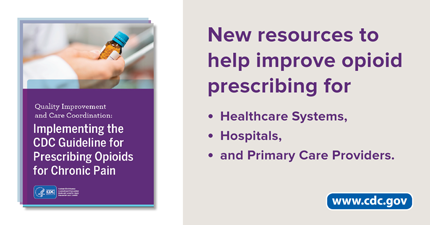In order to prescribe or dispense buprenorphine, physicians must qualify for a physician waiver, which includes completing eight hours of required training and applying for a physician waiver. Physicians can complete the Online Request for Patient Limit Increase.
Improving the way opioids are prescribed through clinical practice guidelines can ensure patients have access to safer, more effective chronic pain treatment while reducing the number of people who misuse, abuse, or overdose from these drugs. Chronic pain is common, multidimensional, and individualized, and treatment can be challenging for healthcare providers as well as patients.
SAMHSA Releases New Resources on Addressing Opioid Use Disorder in Mothers-to-be
The Substance Abuse and Mental Health Services Administration (SAMHSA) has published four Healthy Pregnancy Healthy Baby fact sheets: Opioid Use Disorder and Pregnancy; Treating Opioid Use Disorder During Pregnancy; Treating Babies Who Were Exposed to Opioids Before Birth; and Good Care While Receiving Opioid Use Disorder Treatment. The documents aim to educate patients and health care providers about the best options for mother and baby. In an announcement about the fact sheets, SAMHSA notes that the outcomes for those who participate in a program that offers medication-assisted treatment (MAT) are outweighed by the risks of not being in treatment, and that when properly managed, continuing MAT during pregnancy is the best choice for the mother and the baby.
About the Addiction Medicine Subspecialty
Addiction Medicine (ADM) is now a recognized physician subspecialty of the American Board of Medical Specialties (ABMS). Credentialed ADM subspecialists serve as clinical experts, faculty, teachers, researchers, and change agents. They provide prevention, evaluation, diagnosis, and treatment services for patients with unhealthy substance use or substance-related health conditions. ADM physicians through the AlaHope Program can assist family members who are affected by a loved one’s substance use or addiction.
CME/CE Activities
Take advantage of the ADA’s free online continuing education courses covering the latest techniques for prescribing opioids safely and effectively. The webinars are:
- free;
- convenient to access;
- tailored to pain management in dentistry; and
- available to members and non-members alike.
Plus, the ADA CERP credential provides a sound basis for state regulatory agencies to accept continuing education (CE) credit for licensure.
Screening, Brief Intervention, and Referral to Treatment (SBIRT) is an evidence-based practice used to identify, reduce, and prevent problematic use, abuse, and dependence on alcohol and illicit drugs. The SBIRT model was initiated by an Institute of Medicine recommendation that called for community-based screening for health risk behaviors, including substance use.
![]()
The National Center for Injury Prevention and Control has developed and released the Quality Improvement and Care Coordination: Implementing the CDC Guideline for Prescribing Opioids for Chronic Pain. The quality improvement (QI) measures provided in the resource are meant to be flexible so that healthcare systems and practice leaders can pick interventions that will work best for their practice and patient population. They are offered as voluntary measures that could help incorporate the evidence contained in the CDC’s Guideline for Prescribing Opioids for Chronic Pain in the clinical workflow. The purpose of the resource is to encourage careful and selective use of long-term opioid therapy in the context of managing chronic pain through:

- evidence-based prescribing,
- quality improvement (QI) measures to advance the integration of the guideline into clinical practice; and
- practice-level strategies to improve care coordination.
- A resource toolkit
Learn More: CDC Opioid Overdose Prevention
